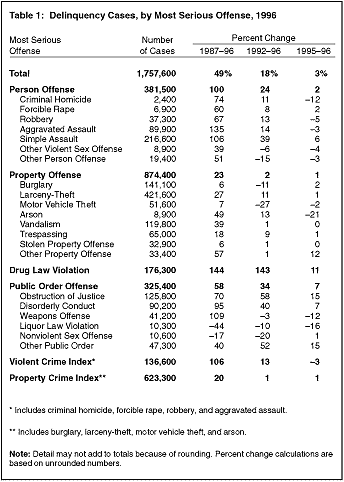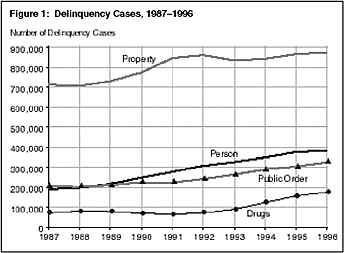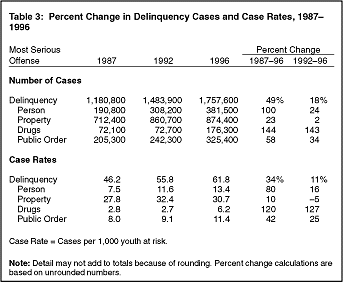|
In 1996, courts with juvenile jurisdiction handled an estimated 1,757,600 delinquency cases, representing a 3% increase over the 1995 caseload (table 1). Delinquency offenses are acts committed by juveniles that could result in criminal prosecution if committed by an adult. Between 1987 and 1996, the number of delinquency cases processed by U.S. juvenile courts increased 49%.
Caseloads increased steadily between 1987 and 1996 across all four major offense categories—person, property, drug law violations, and public order (figure 1). The number of person offense cases increased 100% between 1987 and 1996, property offense cases increased 23%, drug law violation cases increased 144%, and public order offense cases grew 58%. Compared with 1987, juvenile courts in 1996 handled 135% more aggravated assault cases, 109% more weapons offense cases, 106% more simple assault cases, 74% more criminal homicide cases, 67% more robbery cases, and 60% more rape cases. Between 1995 and 1996, caseloads dropped in several offense categories, including arson (21%), criminal homicide (12%), weapons offenses (12%), and robbery (5%).
Examination of the caseloads of juvenile courts using the FBI crime indexes indicates that juvenile courts handled substantially more Violent Crime Index offense cases in 1996 than in 1987 (106%), while cases involving Property Crime Index offenses increased 20%.3 The increases in juvenile court cases parallel the increases in arrests of persons under the age of 18, as reported by the FBI. Between 1987 and 1996, the number of arrests involving persons under the age of 18 charged with Violent Crime Index offenses increased 60%, while arrests of youth for Property Crime Index offenses increased 8%. (See Crime in the United States 1996.) According to the FBI, the number of juvenile arrests for homicide increased 51% between 1987 and 1996 but decreased 14% between 1995 and 1996, changes that closely correspond to the trends in juvenile court cases involving homicide charges.
The offense profile of juvenile court caseloads changed somewhat between 1987 and 1996 (table 2). The relative proportion of person offenses increased, while property offenses declined. A person offense, such as robbery or assault, was the most serious charge in 22% of delinquency cases in 1996, compared with 16% in 1987. A property offense, such as shoplifting, burglary, or vandalism, was the most serious charge in 50% of the delinquency cases handled by juvenile courts in 1996 versus 60% in 1987. The proportion of drug law violations, such as possession or sale of controlled substances, rose from 6% in 1987 to 10% in 1996; the proportion of public order offenses, such as possession of a weapon or disorderly conduct, increased from 17% to 19%.
In 1996, juvenile courts processed 61.8 delinquency cases for every 1,000 juveniles in the population—those age 10 or older who were under the jurisdiction of a juvenile court (table 3).4 Analysis of this case rate permits comparisons of juvenile court activity over time while controlling for differences in the juvenile population.
The total delinquency case rate rose 34% from 1987 to 1996.5 During the same time period, case rates increased in all four general offense categories. The case rate for person offenses grew 80%, the property case rate increased 10%, the rate of drug cases climbed 120%, and the rate of public order offense cases increased 42%. Over the more recent 5-year period, however, the property case rate declined 5%.
|



